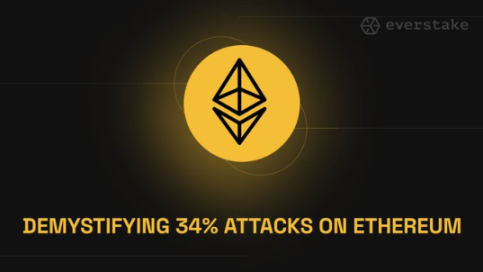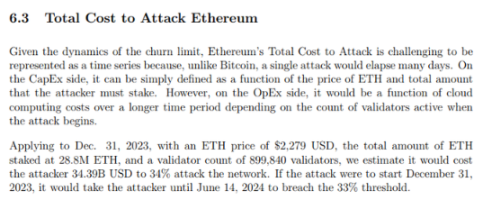How much does it cost to launch an LSD attack on Ethereum?
Author: @eth_everstake
Translation: Baihua Blockchain
Researchers from @coinmetrics, @LucasNuzzi, @kylewaters_, and @matiasandroid, recently published their findings on the security of @ethereum, pointing out that if someone's goal is to destroy the blockchain, launching a 34% attack on Ethereum is no longer feasible, as it would cost the GDP of Slovenia in 2022.
Estimated attack duration: 8 months, with costs exceeding $59 billion, requiring over 1,000 nodes and $2 million in expenses just on AWS.
Many believe that the ongoing growth of liquid staking derivatives (LSD) poses a serious threat to the Ethereum network.
In related analyses, we find that concerns about a 34% staking attack potentially launched by @LidoFinance validators have become unreasonable and highly exaggerated.
Researchers have demonstrated that such an attack is not only extremely time-consuming but also exceedingly expensive for those attempting to leverage LSD to attack Ethereum.
The simulated time-consuming attack (TCA) shows that LSDs cannot purchase access to block templates. Contrary to assumptions, attackers need to buy Ether (ETH).
Given the dynamic withdrawal limits, the total cost of attacking Ethereum is difficult to express as a time series, as unlike Bitcoin, an attack may take several days. In terms of capital expenditure, it can be simply defined as a function of the price of Ether and the total amount the attacker must stake. However, in terms of operational expenditure, it will be a function that depends on the number of active validators at the start of the attack and the long-term costs of cloud computing.
As of December 31, 2023, with the price of Ether at $2,279, a total locked amount of 28.8 million ETH, and 899,840 validators, we estimate that an attacker launching a 34% attack on the network would cost $34.39 billion. If the attack starts on December 31, 2023, the attacker would need until June 14, 2024, to breach the 33% threshold.
However, with the current rise in ETH prices, the costs not only become higher but also become outrageous and unbelievable. Here are the results I calculated.
On March 5, 2024, with the price of Ether at $3,800, a total locked amount of 31.32 million ETH or 9.7888 million validators, an attacker would need $59.63 billion to launch a 34% attack on the Ethereum network.
Furthermore, if according to my post, the attacker understands they are willing to bear this cost and decides to launch the attack starting today, they would need to spend 265 days from today, or until Monday, November 25, 2024, to reach the 33% threshold, as only 1,800 validators are joining the chain daily after the Dencun upgrade.
There are many assumptions and concerns regarding Bitcoin's 51% attack and Ethereum's 34% attack. However, the costs and benefits associated with implementing these attacks remain a mystery.
We propose a novel model to quantify the costs of breaching the Byzantine fault tolerance thresholds of Bitcoin and Ethereum. We introduce a new metric called "Total Cost of Attack" (TCA), which encompasses the operational and capital expenditures associated with these attacks. We explore the motivations and expected utilities of profit-driven and ideology-driven actors.
Our findings indicate that the current security status of Bitcoin and Ethereum renders attacks economically unfeasible and provides empirical evidence for Nash equilibria within these networks. This research also challenges the notion of a linear relationship between fee revenue and network security, which is often assumed in discussions about the decline of Bitcoin subsidies. Instead, our findings suggest that block producers engage in speculative behavior before fee cycles, even when fees are low and declining, ultimately enhancing network security. We hope our analysis contributes to discussions on the long-term viability of the deflationary monetary policies used in Bitcoin and Ethereum and their impact on miner incentives and network security.












